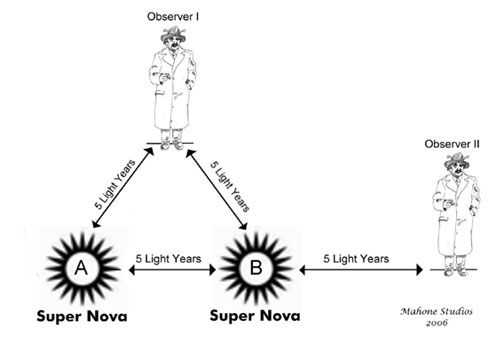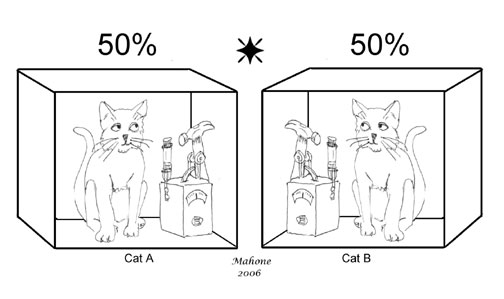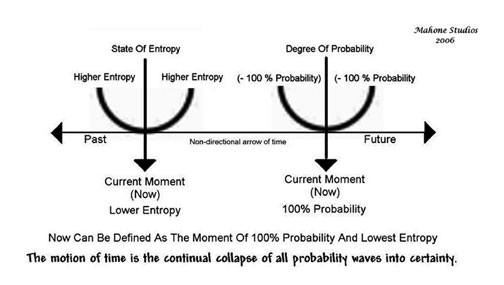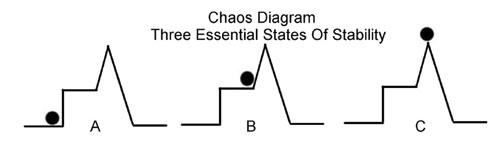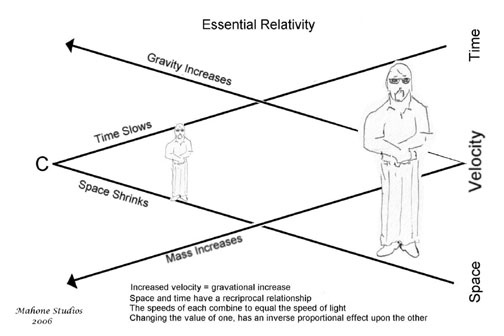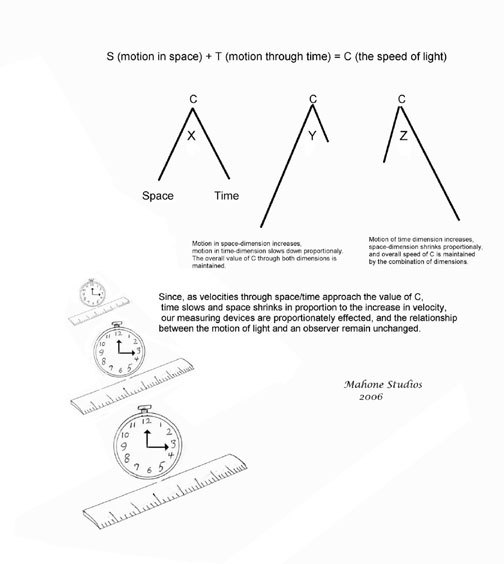|
Home
|
The Shocking Truth About Entropy And Other Disquieting Thoughts About Reality If you have studied quantum physics and are not confused, then it is evident that you simply have not understood what you've read. - Mahone
(Editor’s Note to regular readers: Please skip this post. It is merely for Mahone’s amusement. In fact, everyone should skip this post, as it is simply his way of establishing a proprietary relationship to certain theorems presented here within. Truth be told, I fear Mahone may have taken to drink again.) You may well ask What is entropy and why is Mahone so concerned about it? We will get into that in minute . . . when I'm a little better organized. It is true that not many of us read much about physics. We simply don't have the time, what between watching the Sopranos and worrying about the Mexicans (Uh, excuse me. I meant to say Hispanics from Mexico) flooding the country and overwhelming our social service systems, or worrying about Islamic terrorists who want to take over the world and make us pray five times a day, or the dangerous stupidity of the American Left (a group so devoid of historical perspective and so morally twisted that they still think Mao had some pretty good ideas and that Fidel Castro is a fine respectable fellow who is deeply concerned for the peons) Given all that, it is easy to understand why most Americans fail to get excited about the search for gravitons, or bother worrying about how the theory of branes impacts string theory, or whether or not scientists will track down the elusive TOE (theory of everything, i.e., Einstein’s elusive unified field) before supper time. Science is not for the feint of heart these days. It is a nerve racking and contentious field. Professors of astrophysicists lose sleep worrying that Jesse Jackson or Al Sharpton will picket them for using the term black-hole in the classroom (they prefer the term "light-deprived gravitational vortex" be used). As well, theoretical physicists and applied physicists frequently come to blows at conventions - hitting each other over the head with various branes, stepping on each other’s TOEs, trying to strangle one another with competing string theories, or just acting rascally and filling each other’s gas tanks with anti-matter. Modern physics is not something the average guy wants to get involved with. So, having plenty of time on my hands - there being nothing but Judge Judy reruns on TV in the afternoon - and to spare you some rather tedious reading, I decided to shrug off my usual ennui and once more wade into the murky waters of astrophysics, and to try and ford its untidy little brother, quantum physics. Hence, I read several books relating to the cutting edge of modern science - was immediately overcome with febrile seizures, and took to bed. After a course of analgesics, and a suitable period of reflection, I decided to share some of my thoughts with you. Entropy, Probability, And Reality Back to our primary question, What is entropy? As physicist and Carl Sagan heir apparent Brian Greene explains in The Fabric Of The Cosmos, entropy is a measure of the amount of disorder in a system. Low entropy equates with high order in a system while high entropy indicates maximum confusion and randomness - which is the natural state of the universe. Or so they say. Simply put, the more ways there are for a thing to occur, the more possible states it can be in, the more likely one is to find it in a random than a specific state; i.e., a state of more disorder than order. For example, if you take a thousand page book, separate the pages from the cover and binding, then throw the pages into the air, there are many possible ways for those pages to combine when they come down. If there are, for example, a thousand single-sided sheets of paper involved, then there are thousands of random combinations the pages can come down in; conversely, for all the tossed pages to land in the correct numerical sequence - one through one-thousand - an ordered sequence, there is only one way. Hence, odds are more than a 1000/1 that the pages will land in some random sequence. Since the odds against order are so great, our scientific savants tell us that it is logical for the universe to reflect a maximum state of disorder. Trying to understand and codify the rules of entropy, making sense of the rules of order and randomness, statistics and probability within a particular system, is also what also makes Texas Hold ‘Em poker such a fun way to go broke. As Brian Greene explains, "The tendency of physical systems to evolve toward states of higher entropy is known as the second law of thermodynamics. (The first law is the conservation of energy). Remember this. There will be a test next Tuesday. Time What is time, and why does it seem to always make me late for work? More importantly, why do we experience a sense of being carried along by it and why can't physics explain that? Physicists have no credible explanation for, and scant recognition of, time. It remains an enigma. This vexes know-it-all, or want-to-be-know-it-all, physicists to no end. In fact, time is held in such low regard that theoretical physicist Julian Barbuor has decided to banish it like a demon. In his magnum opus, The End Of Time (an extensive and complex book which has the added value of being a proven cure for insomnia) Barbour argues quite persuasively against time's existence! And this is actually pretty sound reasoning on Barbour's part; since nobody can say exactly what time is, nor has anyone identified a chrono-nucleus with tiny nano-grains-of-sand orbiting it - much less developed a mathematical theorem explaining time's function - then who is to argue on time's behalf if he simply does away with it? Time, like emotions such as love, hate and regret, is simply a fallacy of the human imagination - a nasty by-product of a bulging forebrain. Since Barbour had a relative degree of economic independence, and a degree in physics - and lots of time on his hands - he basically decided it would be nice to sit around thinking about time for a couple of decades. The End Of Time is the sum of his prodigious mentation. In Barbour's theorem, the universe is one big primal ball of interpenetrating energies, in the form of wave fields, a dense thicket of all potentialities, consisting of everything that has every existed, or will exist. If you imagine energy waves as strings, then the universe is one gigantic ball of yarn, where every intersection is a tree or a rock somewhere in four dimensional space/time. In this big ball of yarn, everything that has ever happened, or will happen, is occurring simultaneously. That sure puts the mortgage payment into perspective. However, the very concept of simultaneity may be in questionable. Barbour, like most physicists, doesn't venture a credible explanation as to why we all collectively hallucinate flowing along this imaginary river that seems to posit a future that is always just around the next bend and a past that is irretrievably lost. Time - like color, a sense of independence from other beings, and the feeling that we are somehow basically different from rocks - is merely an abstraction, one more inexplicable illusion of human perception. Brian Greene, in The Fabric Of The Cosmos, also presents a similar view of a static universe where ever thing that has ever existed or will exist in time is still somewhere in space/time. In the movie, Gladiator, a Roman general tells his troops before they enter into battle that "What you do here today will echo through eternity." According to modern physics, when it comes to reality, this may be more than a rhetorical flourish. A Word About Locality And Simultaneity Physicists say that information in the universe can not proceed faster than the speed of light. (Remember: the speed of light is not just a good idea: it’s the law!) What ever happens anywhere, its influence, or any information imparted by it, can not proceed to the rest of the universe faster than the light that emanates from it. Everything within the scope of the expanding light cone is within the locality of the event. This is called the "locality assumption." A simple example of relativity and locality is seen in diagram 1 below. Here, we have two super novas, A and B, exploding. They are equidistant from each other, by exactly five light years, and both are at the edges of an equilateral triangle which has Observer I at the other tip. At a right angle to Observer I, and five light years from Super Nova B, is Observer II. From Observer I's position in the space/time continuum, A and B explode simultaneously. From Observer II's position, B explodes first, followed five years later by the explosion of A. For observers who remain in orbit around A and B - sitting inside heavily wrapped asbestos spaceships, their own explosion occurs first, followed two-and-a-half light years later by the explosion of the other. Thus, the universe provides no absolute frame of reference for the unfoldment of things in time. Everything is dependent upon your position at any given instant, and the locality assumption dictates that no immediate transmission of information can occur. However, if the locality assumption does not hold up, then all bets are off. In fact, everything may be occurring at the same instant in space/time, with only your relative position giving the illusion of separation. Why There Is A 50/50 Probability That Cats Hate Erwin Schrödinger Quantum physics says that a particle’s (or wavicle - not exactly a particle, nor a wave, but something that demonstrates properties of each, depending on the experimental situation) position and speed can not both be known with exactitude at the same moment. If you know the particle' position at any given moment, you can't know its speed accurately; conversely, it you know its correct speed, you can' assign a definite position to it. As John Gribbin explains in Schrödinger’s Kittens And The Search For Reality, the position of an elementary particle such as an electron exists in no specific place, but in a ‘cloud of probability.’ There is a certain probability that it is here, another degree of probability that it is over there. When, by observation, we assign a definite position to the electron (making a correct estimation of it’s speed impossible) we ‘collapse’ its probability wave into a certainty. Until that moment, the electron hovers here and there in a cloud of probability, with each probability equally real. From such things as the simple collapse of a probability wave of an elementary particle, quantum theorists have spun whole galaxies of mind-torqueing hypotheses. Here is a stripped-down paradigm of one world-view changing theory - one that posits a shocking violation of the locality assumption. This is the paradox of Schrödinger's cat, (after Erwin Schrödinger’s, whose thought experiment this was). A cat is placed in a box. An atomic element capable of decay is let lose in the box. Then a partition is let down in the middle of the box to separate the cat's side of the box from the empty side. Because we don't know the exact position of the particle, there is a 50/50 chance that it is in either side of the box. Also in the box, on the cat's side, is a detector that registers the decay of this element, and then sets off a process that releases cyanide gas, (a hammer breaks a sealed vial of the gas) which will kill the cat. So, before opening the box to see which outcome - dead cat or live cat - has occurred to collapse quantum probability into a reality, What is the state of the cat in the box? There is a fifty percent chance that it is Dead. And a fifty percent chance that it is alive. According to quantum theory, until a person collapses the probability waves by opening the box and making one outcome real by observation, the cat exists in both states!, a strange reality, a flux, where all probabilities overlap and are equally valid until one reality is selected. All probabilities are equally real until an observer makes the universe choose. This is sound quantum theory. But it gets stranger: Schrödinger’s cat has kittens. Take two cats, set up the same basic experiment; (diagram 2) however, this time there is a cat in each side of the box, which will leave one definitely dead and the other alive at the end of the experiment. To further complicate matters, we separate the sealed boxes, leave one on earth (Cat A) and place the other (Cat B) on a rocket ship headed to Alpha Base One on a planet out near Alpha Centauri, (which, if you use the shortcut which bypasses the Horsehead Nebula, is a journey of approximately four light years). Meanwhile, each of the cats (who have been specially bred for longevity to survive experiments in quantum physics) exist in a quantum no-man's-land, with both possible states of existence overlapping. Only when cat B arrives on Alpha Centauri and someone opens the door on the box/rocketship, is the probability wave collapsed into one state or the other and the issue of its fate decided. Here is the kicker: By collapsing the probability wave of Cat B on Alpha Centauri, Cat A's state back on earth is also instantaneously decided! Instant affect, over four light years, violates the locality assumption that much of astrophysics is based upon. Nothing should act on anything else faster than the speed of light. And then the other moonboot drops: by deciding the fate of Cat B, you have reached back into the past by four light years and decided the fate of Cat A! The results of the theory may be bizarre, but, supposedly, Schrödinger's conclusions are based upon solid quantum theory - he merely extrapolates a logical conclusion from the quantum realm to the macro realm. Even though quantum theory is generally sound - the fact that your computer is working right now is the result of applied quantum theory - there are those theorists who believe that though "fuzzy" probabilistic reasoning does hold sway in the quantum realm, all dualities are resolved before leaving that domain and entering macro reality. Whatever the ultimate truth of the situation, until such time as a pair of cats can be found that can survive a multi-light-year voyage in a box, Schrödinger's theory will remain an interesting thought experiment - or experimenters will have to find a non-feline way of testing it for proofs. What Is Now, Is It Actually Unique, And How Does It Relate To Entropy & Probability At one time - even though a directional time arrow was not recognized in equations - physicists considered entropy to be the best candidate for a relational link to our unique experience of a sense of the present, something that provided a mobile dividing line between events. Things become more disorganized as time moves on. The direction in which entropy increases is the future. But as Brian Greene points out, this sets up a real paradox because those same rules of physics that do not recognize a directional-time-function in equations also posit a situation where entropy increases in the opposite direction - the past. We are back to where we started regarding explaining what ‘now’ is. Observation and reflection have led me to conclude that quantum theory does provide an explanation, of sorts. Brian Greene gives us a U-shaped diagram that demonstrates the true relationship of entropy to the moving time line (The left-hand part of the illustration in diagram 3). In the middle of the U, at the bottom, is the current moment. The arms of the U represent the level of entropy surrounding the current moment - greater both before and after. What I find fascinating is that, diagrammatically, both entropy and probability have an exact relation to each other and the ‘now’ moment. The moment we consider "now" is when All probabilities are 100%. No matter their state prior to this, no matter how improbable they were before hand, or how improbable they become afterwards, all systems have a complete probability at this moment. This moment, as well, is what we perceive as the "now" with our conscious minds. Therefore, the break between the implied directional arrow of time in equations for physical systems, is the moment when all probabilities have been brought from potentiality into being; "Now" is the imperceptible moment when all probability waves are collapsed; i.e., the mobile feeling of moving toward the future is the crest of a wave we are riding, a breaking wave of probability. Now is the transient point where all probability waves collapse into certainty. (In Julian Barbour’s theory, I suppose, any location in time and space would qualify as the ‘now’ moment, or the point where any probability wave collapses. Only our feeling of mobility, of traversing a particular path, varies. ) Though chaos and disorder may exist in the past and in the future, Now is perfect as it is, and, in a very real sense, eternal. We are always in the center of the U-shaped entropy diagram; so, though the dragons of time devour us from each end, we are huddled safely in the arms of the . . . well, for lack of a more adequate metaphor, God. Masterful Egyptian iconologist, R. A. Schwaller De Lubiz, writing in The Symbol And The Symbolic, suggested that the Egyptian symbol of the Aker-lions represented something similar to the concept of the ‘now’ as an always replenishing moment. The Aker-lion symbol consists of two lions, seated back to back, with the symbol of eternity (the Uroborus, or serpent swallowing its tail) poised between them. Inside the Uroborus is the child Hours, seated on a sign for the horizon. Hence, like our diagram of the collapsing of probability waves, it symbolizes the eternal now. The Dragons Of Chaos Chaos Theory is a method of assigning mathematical values (probabilities) to elements within various systems, a sort of geometrical calculus of change, that is achieved by converting the mathematical probabilities into diagrams and examining them for stability and instability. In other words - be it metal stress in a steel girder in a sky scrapper, the pressure on colliding tectonic plates, or buying and selling trends on the stock market - chaos theory is used to codify a system mathematically so that its stability or tendency to enter into a sudden phase transition (either go chaotic or mutate into another system) can be predicted - and as a result either go chaotic, or experiences a phase transition to a new state of energy and order. With variation, there are only three basic states for any system. A lowest energy state (what most systems seek, and co-equivalent with a high entropic system) where maximum energy is needed to change the state; a mid-level state where the addition of energy can boost it to a either a higher or lower state (50/50% probability) and a high energy state (equivalent with a low entropic system), where a minimum of energy input can destabilize the system and thereby send it to a lower state. (See diagram 4) The lower the entropy for a given system (the amount of organization it has), the more likely it is to destabilize into higher entropic states (more disorder). The world can only be what it is, and nothing else. In actuality, probability and improbability, do not exist - save as fictions of science; they are, in essence, modern soothsaying tools (though pretty good ones) to help us detect the course of asteroids and the whims of stock buyers. Whatever order and complexity the universe currently contains was mandated from whatever beginning it had. Why Relativity Is So Special The Importance Of Symmetry And The End Of The Universe In physics, the concept of symmetry is of absolute importance. Symmetry is the ability of a thing to be unchanged by rotation. (A ball, for example, has perfect symmetry, while an elephant does not look the same if rotated by 180 degrees.) A hexagon has six-fold symmetry. You can rotate it by sixty degrees and it looks the same, or it can be replaced by any other hexagram, since they have the same symmetry. Electrons and certain sub-atomic particles have a great degree of symmetry, hence can be substituted for each other with no loss of function or purpose. All existence is the result of two things: heat variance, and broken, or imperfect, symmetry. Because things are not completely symmetrical, they are not the same. And the higher we go up the scale of life, the more variety we have in things. This is why, for example, Boy George is not the same as Genghis Khan, and Madonna is noticeably different from Mother Teresa. There is also a symmetrical relationship between space, time, and the speed of light. We generally understand that it is impossible for things to move at the speed of light. Not true. We are moving in multiple dimensions, two of which are the combined dimensions of spacetime. When the speed of objects in space is combined with the speed of their motion in time, the combined value always equals C (the speed of light). Space and time have a reciprocal relationship with the speed of light. Changing the value of one has an inverse proportional effect on the other. Imagine and inverted V. One leg is space, the other time. The combined value of their speed, at the tip, is C. That is, if you increase speed in space, (lengthen the space leg), you change the speed of the other dimension (the time leg shortens proportionably), yet, the combined value of the two always equals C. (Diagrams 5 & 6 illustrate these relationships). Back to symmetry. Supposedly, due to entropy, the universe will just muddle to a stop one day, with everything becoming one big cosmic flux of disorganized nothingness. Liberals will like the end of the universe. The initial quantum soup that gave rise to us will first grow tepid, then cold, and perfect symmetry will have been achieved at last. Absolute equality - perfect enough to make a Washington egalitarian's heart glow like a skeleton from Hiroshima - will at last be achieved, with no thing any different than any other thing. At that point, no matter how you rotate politicians, political parties, or ideologies, no one will want to move - much less pay taxes or work anymore - so everything will just cool off and grind to a halt. Perfect equality will at last have been achieved in the universe. Make of all this what you will. |
